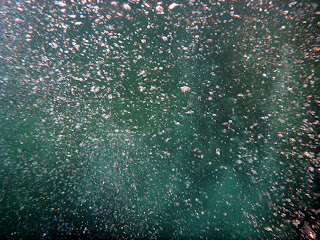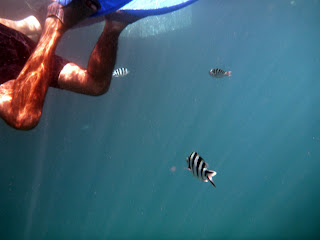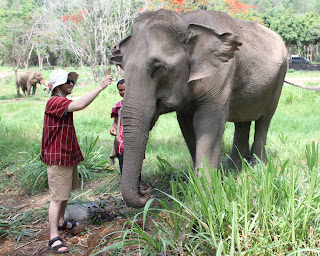About two and a half months ago, Justin and I went to
Patara Elephant Farm. I know that's a long time ago, and I'm sorry about how confusing it this makes it to read our blogs. The reason it's taken so long to write about riding elephants is that riding elephants is colossally hard to describe. I mean, how do you explain how it feels to have your hand gummed by an elephant devouring chunks of banana? Or to sit ten feet off the ground, bareback, while six thousand pounds of endangered animal bears you up a mountain? Or to swim on aforementioned mountain with aforementioned animal, under a freaking
waterfall, reaching such familiarity with a baby elephant that when it bumps around too close during swimming, you just laugh and shove it out of the way?
There's only one word I can think of for it: magic.
When I say this, you can take me seriously, because I'm not an elephant person. I had two main reasons for setting up this day riding elephants in Thailand: first, my uncle Drew loves elephants, and we were out flying the flag for the family; and second, I figured I had to try it once.
Well, I'm a convert. (Did you notice?) If I lived in Chiang Mai, I'd bankrupt myself scheduling elephant rides. It would be my class's annual field trip and my personal weekend hobby. Going to Chiang Mai without going to Patara would be like going to Orlando and missing Disney, going to Arizona and missing the Grand Canyon, and going to Paris and missing the Eiffel Tower - all on the same trip.
Please note, by the way, that Patara is different from other elephant experiences in Chiang Mai. There are places where elephants are chained or poked with hooks or taught to play soccer or forcibly bred (apparently at Patara, when elephants seem interested in each other, they are allowed to wander up into the mountains for a "honeymoon;" what they do there is up to them). I saw no evidence of unhappy or unhealthy elephants at Patara, and although I strongly recommend Patara to visitors, I can't speak to any other locations. If you are going to Chiang Mai, please choose carefully. I picked Patara after reading the
experiences of my coworkers. Patara is the most expensive elephant excursion in Chiang Mai, but I think there's good reason for that, and it's completely worth it.
Our day started when the air-conditioned van picked us up at our hotel. When we arrived at Patara, there were two female elephants and two babies waiting to greet us.
Four elephants, approximately eighteen visitors, and zero fences. We could go right up to the elephants, and they could come right up to us. Which they did, as soon as the staff gave us bananas and sugar cane. Let me tell you, up close, those things are huge: ten feet at the shoulder, and
depending on the elephant, weighing as much as two to four Volkswagen
Beetles.
Honestly, I could have gone home then and not felt like it was a wasted day. This was the theme for the day - every time we did something, I thought it was so cool that I could go home happy, and then Patara would top it with something even cooler.
 |
| Pictured: A satisfied customer. And the day has just begun! |
Elephants have amazing personalities. There are greedy ones, and mellow ones, and crotchety ones, and every other adjective you can name. The little ones were hilariously bratty, I even got partially stepped on on my ankle (Best.
Bruise. Ever!).
 |
| But Mommmmm! All the other kids get to eat sugar cane and stay up late! |
Interestingly, if you see a young elephant with an adult, they're not necessarily related. Female adult elephants form groups to care jointly for the children. The owner of Patara told a story about a wonderful symmetrical photograph of the two Patara juveniles nursing from their mothers, except the kids were with the opposite parent.
Next, we listened to a brief introduction to elephants from the owners (did you know pregnancies typically last 18-24 months???). The staff kitted us out in traditional elephant-riding ponchos and passed out baskets of food, with which to buy our way into the favors of our assigned elephants.
 |
|
The Patara program is called "Elephant owner for a day." Justin's was an older female named Mei Kham Souk, and mine was a younger female (30-something) named Ma Ree, or maybe Ma Ri, or maybe just Marie. Being "owner" for a day means you don't just show up and ride; you have to do the caretaking work which mahouts (elephant trainers) have to do to keep the elephants healthy. Each Patara elephant has a permanent trainer (all males), and on the days when the elephant isn't working with tourists, the trainers are responsible for the entire routine: health check, feeding, bathing, exercising, etc. It's hard work and they have to be on call 24/7 for any emergencies. Based on the conditions of the Patara elephants, they are very good at it.
 |
| Elephant 101 |
How do you know an elephant is healthy? I don't know if I'm remembering all the signs, but we definitely checked for:
1) Grass flattened in a particular pattern, indicating a good night's sleep.
2) "Happy" ear movement, to indicate a relaxed elephant. Unhappy elephants are not ridden.
3) Healthy feet, evidenced by toenail sweat. Yes, the only place an elephant sweats is above the toenails!
4) General good health and good diet, evidenced by dung. Good dung is fibrous and does not contain large chunks of leaf. It also smells like fresh grass.
 |
| A piquant bouquet? |
 |
| Verdict: Grassy! |
It also produces liquid when squeezed.
 |
| Even the trainer suspects he's just pranking us. |
Worth pointing out that Patara was an incredible day, but not for the squeamish. If you can't handle squeezing the elephant poop at this point in the day, you'll be really unhappy swimming with it later.
A healthy regular elephant produces a certain number of dung balls overnight. I can't remember exactly how many - six to eight, maybe?- but they told a story about how one morning they counted and an elephant had produced 11. They discovered later that she'd wandered away from Patara the night before and eaten a farmer's entire banana tree, which the farm had to pay to replace.
After checking your elephant, you get to know each other a bit through feeding. The command "Bom!" is meant to get your elephant to open its mouth.
Justin feeds Mei Kham Souk:
I feed Ma Ree:
Then you have to clean your elephant. Elephants throw dirt on their back to act as sunscreen, and also as protection from flies. To keep their skin in good condition, you have to clean it off. The dust can actually form hard cakes, like what you see on a dried mud puddle, so in order to loosen it, you whack at it with a bundle of plant, interspersed with bristly brushing.
My elephant, Ma Ree, had a pretty mellow personality. She was clearly unimpressed by my strength, and her trainer kept telling me to swat harder. I suppose from the elephant's point of view, it feels a bit like when you dust off your shoulders? You can tell from this video that she was neither uncomfortable nor annoyed by the process, and actually seems to be telling me which spot to work on next:
Next, you took the elephant to the river and got to work with the scrubby brush. You need to focus on the face - the trunk, which you brush up-and-down, the ears, which you brush across, and the face, which you brush along the wrinkles. You do the sides and legs, too, checking all the while for skin lesions or cuts
I told you Ma Ree was mellow.
You can see my trainer using basket with a strange set of handles - a giant X - to scoop and fling water over the elephant to wash away the dirt I've loosened. You don't use the bucket as a bail, or it gets too heavy and you get too tired. Just skim the top of the water and let the splash flow over the elephant.
To my surprise, underneath all that, the elephants are actually a cheery pink. You can tell how strongly someone scrubbed their elephants by how much pink you see. The flaps of the ears and the nose get pinkest.
 |
| Before... |
 |
| After! |
A brief break followed, then we learned how to board and ride. (See
my earlier blog post for that tutorial). And we were off!
How do you sit on an elephant? At Patara, you sit bareback (and barefoot) on the elephant's neck, not in a box on the spine, which I've heard is not healthy for the elephants. I've ridden horses, and there is some similarity there, especially in the rocking motion. But an elephant is definitely not a horse. You sit bunched up behind the elephant's ears in a crouch position which takes a LOT of getting used to.
Justin hurt his knee skiing years ago and had some issues with the position. I'm pretty flexible, but I felt the pinch on the backs of my thighs, and my feet were going to sleep on and off.
 |
| Cool pose, or desperate attempt to prevent varicose veins? Hint: B. |
To tell the elephant to go forward, you tap lightly behind the ears with the flats of your feet, unless your elephant is mine, Ma Ree. I called her mellow before, but she's also amusingly... efficient. Or lazy, if you prefer. Ma Ree clearly knew the other elephants and the process well enough to know that there would be bottlenecks and moments of slowing down, and she had no intention of walking quickly to catch up only to have to stand around later. Once I figured out what she was doing, I respected her greatly, as this is exactly the same attitude I take regarding braking on my way to a red light. She proved herself the expert, and subsequently I let her drive.
Compared with horses, elephants are indifferent to terrain, plodding
with identical equanimity over plains and mountains and rivers and rocks.
Their pace is stately and inevitable, and you relax into it, like you're in a rocking chair situated on the calm, bristly edge of a glacier. Maybe elephant riding is best considered a cross between riding a horse and sailing a ship. When you sail, you can't control the wind or the water, so you have to find a way to make the wind and the water work for you. Ma Ree wasn't going to change her gait to suit me, so I had to relax into her, sitting forward on her neck to ease the uphills and leaning back to balance on the downslopes, or loosening my hips so I could rock in time to her steps and not feel stiff and jolty.
Justin's Mei Kham Souk is the last elephant in this video. Look for his white hat.
Justin and I are the last two riders in this video. Again, watch for my floppy sun hat and his white hat.
There was a brief break to lead the elephants along a paved road (not that I was really leading Ma Ree). This gave us greenhorns a chance to unkink our knees and hips. It also gave Ma Ree a chance to engage in what seemed to be her favorite hobby - whacking me in the head with her ear.
On the ride back, I noticed that the flies bite elephant ears so hard they draw blood. This is probably because it's the thinnest skin on the elephant. So Ma Ree was actually trying to defend herself, and also probably to cool off. Since I clearly didn't need to focus on giving her directions, I tried to keep flies off her head and ear myself. I like to think she noticed.
Then came the waterfall. And I just can't actually fit that into this post, which is growing absurdly long. So tune in next time for Part III, Swimming with Elephants!





































































